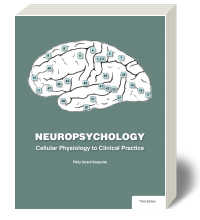

Neuropsychology: Cellular Physiology to Clinical Practice
Third Edition Gasquoine, © 2020, 432 pages
This textbook is suitable for a neuropsychology course.
Request Examination CopyPrices and ISBNs
This title is available in the following formats.
|
Product
Description ISBN |
Description | ISBN | Bookstore (Net Price) |
Student (Retail Price) |
|
TEXTBOOKPlus
Loose Leaf + eBook 978-1-5178-0814-3 |
Loose Leaf + eBook | 978-1-5178-0814-3 (9781517808143) | $73 | $106 |
|
eBookPlus
Online eBook 978-1-5178-0815-0 |
Online eBook | 978-1-5178-0815-0 (9781517808150) | $50 | $73 |
Supplements
The available Supplements are listed below:
Click here to access ancillaries save_altInstant Access (and Coupons)
All students can have free Instant Access to an eBook for the first two weeks of class while they procure their textbook. They will also receive a 10%-off coupon valid at the BVT web store for the best possible price. Get instant access codes here.
Exam Bank
The Exam Bank contains questions in a variety of formats including multiple choice, true/false, short answer, and essay questions.Excerpts
Description
1. This textbook can be used for: (a) undergraduate students taking their first course in behavioral neuroscience with minimal background in the biological sciences; and (b) graduate students who are taking their first course in neuropsychology.
2. Chapters 1 through 12 cover material that can be used in an undergraduate course in behavioral neuroscience. These chapters focus on brain physiology, chemical signaling, psychopharmacology, neuroanatomy, neuroimaging, the neuropsychology of cognition, and common neurological conditions. The material is presented in a straightforward format suitable for undergraduate students being exposed to this information for the first time. These chapters serve as an important review when the text is being used with graduate students, for whom chapters 13 through 18 cover clinical neuropsychological assessment in adults. The special topics covered in chapters 19 and 20 review material pertaining to the neuropsychological assessment of children and brain injury rehabilitation that is suitable for both undergraduate (excepting the latter half of chapter 19) and graduate instruction.
3. Within this textbook neuropsychology is narrowly defined as the use of lesion analysis in human patients to further an understanding of brain/behavior relationships. Clinical neuropsychologists provide services to patients with structural brain injury to assist with diagnosis, management, and treatment.
4. Brain/behavior relationships described are those that are supported by a preponderance of the evidence. Isolated, novel, or unclear brain/behavior relationships are not reviewed.
5. A quantitative/qualitative flexible approach to neuropsychological assessment is described with emphasis upon using individual comparison standards as estimates of preexisting neurocognitive skill levels.
6. Neuropsychological assessment of American minorities is discussed including cases studies of bilingual Hispanic Americans.
7. Mental disorder is conceived as problematic behaviors with psychosocial determinants. There is no reliance on the medical “disease” model of psychopathology that is discussed in detail in chapter 4.
The author declares no conflict of interest in selecting material to be included. He received no funding from any source, including any pharmaceutical company, to assist in production. The responsibility for all errors of commission and omission are the author's alone. This third edition corrected several errors noted in the second edition and updated the literature by adding new material throughout.